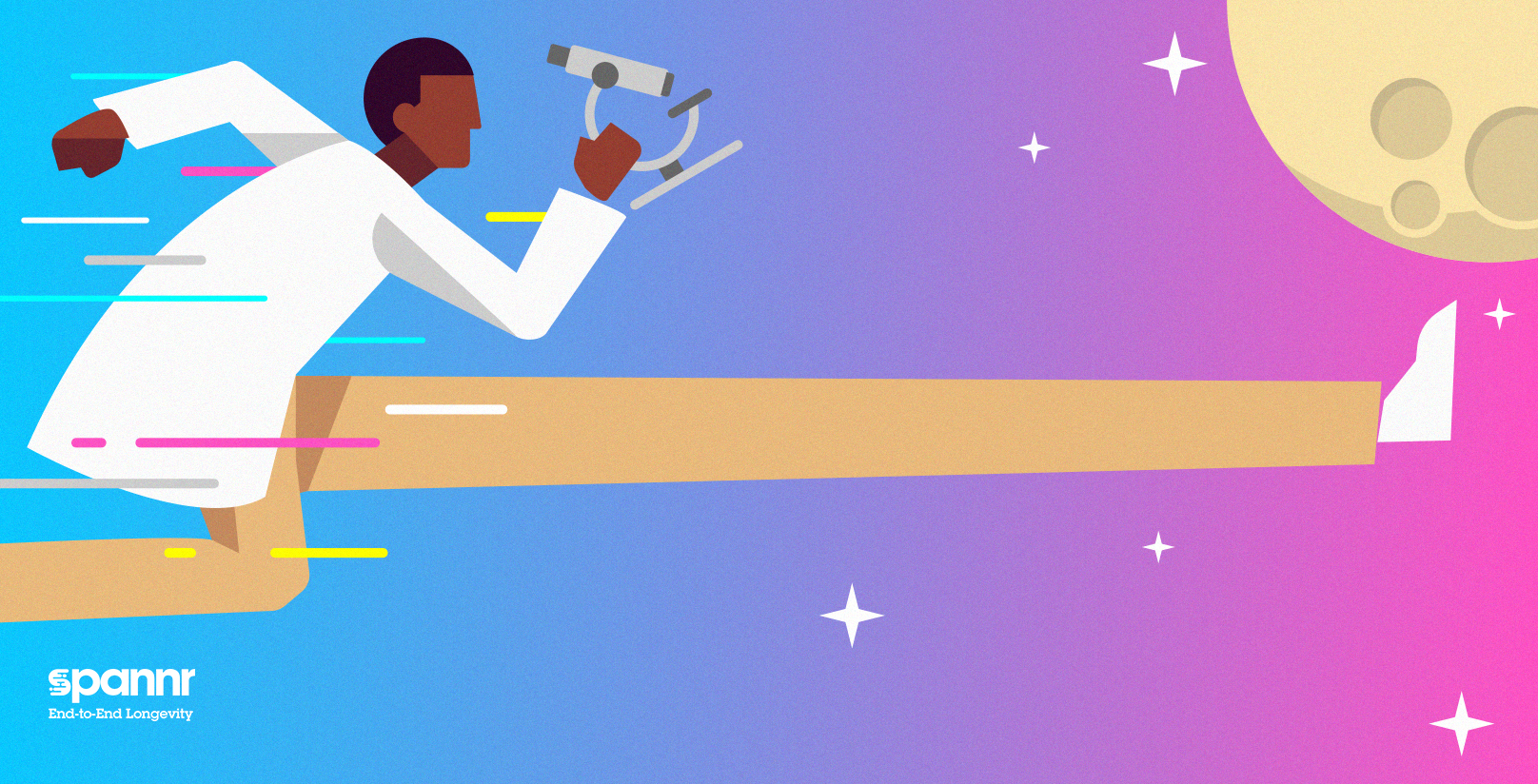One Small Step for Man, One Giant Leap for Longevity?

From the earliest moments of consciousness, humankind looked to the stars for answers.
Much as our forefathers used astrotheology as a predictive tool, today, we are harnessing science in conjunction with space to see what’s happening beneath the hood of our bodies.
While the methods have advanced, our core intent hasn’t. Not satisfied with Earthly bondage, our limitless thirst for knowledge and exploration drives us to the stars. It just so happens that, more recently, we’re finding tools to unlock longevity in that cosmic quest.
The Cosmic Quest To Better Understand The Aging Process
One of the biggest challenges to effective aging and longevity research is that it takes a lifetime. Research on fruit flies and mice doesn’t always reliably translate to human lifespan, and the unpredictability of real-world variables limits digital simulation research.
Today, however, the unprecedented accessibility of space travel for research projects opens new vistas into longevity research.
That’s because merely existing in space – or traveling just slightly past the surly bonds of Earth – has been proven to radically impact the normal aging processes.
Here’s what we know so far…
Tweaked Telomeres
Telomeres are increasingly becoming the gold standard for measuring aging. Telomeres are “endcaps” at the end of our chromosomes. Similar to the plastic tips on the end of shoelaces which keep the lace from fraying, telomeres keep chromosome ends from fraying, protecting our genetic data and making it possible for our cells to divide.
After too many rounds of cell division though, those telomeres can no longer do their job. Each time a cell divides, the telomeres become shorter until they become too short to divide further. The cell then becomes “senescent,” or in other words, it dies.
Whether the effects of aging are directly attributable to telomere shortening is still debatable, but a growing body of research does point to the correlation between the onset of age-related disease and shortened telomeres.
Because of this easy-to-assess proxy for aging, telomeres are the primary focus of research into space’s impact on aging. The hallmark of this research is the recently completed NASA “Twin Study.” During this experiment, researchers measured and compared NASA astronaut Scott Kelly’s telomeres against his earthbound twin Mark’s before and after about a year outside the atmosphere.
The results were startling. Previous research had suggested that telomere shortening could be slowed, but it was impossible for them to reverse (i.e. lengthen). But, when Scott Kelly returned to Earth, researchers found that his telomeres actually lengthened while in space.
The catch? Kelly’s telomeres quickly reversed course, ultimately measuring shorter than they did pre-flight.
Although lengthening telomeres in space might have initially seemed like a promising sign or perhaps even a “fountain of youth,” experts have hypothesized that the unexpected elongation was largely due to increased solar radiation exposure and subsequent oxidative stress.
Similar to what sometimes happens with cancerous tumors, your blood cells are likely fighting to survive. As a result of adapting to their new environment (in this case, space), some cells will activate an alternative pathway to keep their telomeres going – a mechanism known as alternative lengthening of telomeres, or ALT.
In short, although the Twin Study proved that telomeres lengthen in space, the reactionary event ultimately damages your telomeres in the long run. This was, again, proven by the fact that Scott’s telomeres did shrink below their pre-flight levels shortly after traveling back to Earth. Not to mention that space radiation-induced DNA damage, such as chromosomal inversions, is a recipe for increased cancer risk.
Epigenetic Assessment
To make an extremely complex topic somewhat digestible, epigenetic biomarkers measure the amount of DNA methylation (the amount of methyl found in the molecules).
Increased DNA methylation corresponds with increased chronological age. Therefore, epigenetic determination of DNA methylation is an epigenetic clock and an alternative proxy for aging. It is less understood and reliable than telomere measurements.
A foundational study measuring epigenetic biomarkers in space environments came from the Mars-500 mission, an earth-based experiment that simulated an extended trip to Mars. The experiment did not include solar radiation or other effects that are impossible to replicate on Earth but it did provide researchers with means to measure aging through epigenetics.
After completing the 520-day “mission,” researchers compared the participants’ epigenetic biomarkers against pre-mission baselines. During the analyses, they found that methylation of DNA decreased, negating their hypothesis that simulated space travel would increase methylation and, thus, aging.
While unable to account for those unique variables like radiation and gravity changes, researchers hypothesize that modified circadian rhythms and diet could contribute to the slowed biological aging measurements.
While not perfect, epigenetic biomarkers combined with telomeric length did give scientists a clearer picture of space’s effects on aging.
Less Direct Impacts of Space on Aging
While studies looking at the impact of space on epigenetics and telomeres may be the easiest to associate with aging today, less direct – but no less important – research is also being done.
Extraterrestrial Brains
The Oregon Health and Science University, alongside a global cadre of scientists, recently wrapped up a study looking into the neurological effects of space travel and its implications on cognition.
In the study, astronauts had MRIs done before and after long periods in the International Space Station (ISS). Researcher’s sought to measure the astronaut’s perivascular space (the size of the space in which cerebrospinal fluid flows) around the brain. Perivascular space has been shown to be an important aspect of the glymphatic system, which is responsible for the removal of waste from the brain.
Recent studies have shown an association between the enlargement of perivascular space with aging related diseases such as Alzheimer’s and dementia.
The research team theorized that the lack of gravity would enlarge the perivascular space and decrease cognition in small, measurable ways comparable to mild dementia.
While they did find increased perivascular space in all astronauts, it did not come with the neurological or mental issues typically found in grounded patients with normal spacing. This research opens new vistas into blunting the late-stage effects of aging, if not the process itself.
Macrocosmic Musculature
Reduced musculature, weakness, and loss of motor control are all part and parcel of advanced age and contribute directly to mortality as loss of motor control can lead to fatal falls or the inability to exercise and stay in shape. That’s why, much like the research into perivascular space as explained above, research into musculature may provide insight into one of the most common adverse effects of aging.
Beginning in December 2021, researchers have been combining cutting-edge longevity research with state-of-the-art lab technology to better understand why bone and muscle loss happens faster in the weightless environment of space.
A partnership between the University of Liverpool and the UK Space Agency, known as MicroAge, has bioengineered human muscle tissue in a lab and launched the samples into space to do experiments aboard the ISS.
In space, the synthetic muscle cells were electrically stimulated to induce contractions in the muscle tissue – with one part of the samples exposed to microgravity, and others exposed to artificial gravity through centriguation.
Upon the spaceship’s successful return to Earth, MicroAge scientists immediately began studying the results in an effort to potentially reverse muscular degeneration often seen in astronauts due to living in zero gravity.
Peripherally, through these efforts, researchers made significant strides in reducing the carbon footprint of the electrical stimulators from the size of a desk to a deck of cards. This development alone is beneficial in treating adult musculature degeneration and nerve issues, much like today’s Transcutaneous Electrical Nerve Stimulation (TENS) units currently do.
Ultimately, this study may help solve the puzzle of why muscles get weaker with age and will hopefully find ways to prevent the process.
Results of Radiation
For what it’s worth, it’s important to note that radiation and zero gravity exposure in space is the culprit for many unique changes to the biology of our fellow, brave astronauts.
In multiple studies of post-flight blood samples, for example, scientists found blood mutations typically seen only in advanced age – many of which are associated with cancer and heart disease. While there isn’t a definitive link between space travel and these two illnesses, the blood mutations shed light on necessary protective measures if we ever venture past the moon or endure an extended spaceflight.
Orbiting Research
Aside from the research being done on the association between space and longevity, there is also research being done using space to study second order effects of aging.
- Ocular degeneration, or failing eyes in lay terms, is often one of the first detrimental effects of aging and can strike surprisingly early. That’s why scientists are studying the damage that is done to astronaut’s eyes during spaceflight, known as “spaceflight-associated neuro-ocular syndrome,” or SANS. Ongoing studies into SANS may shed light on the reversal of age-induced eye deterioration or at least early treatment.
- One of the most damaging effects of aging is bone mass reduction and osteoporosis. Affecting women disproportionately, bone quality (or lack thereof) is one of the most significant contributing factors to life-ending falls in the elderly. A study completed in July 2022 may shed light on ways to prevent bone mass reduction and hopefully help reverse its course. The study shows that space travel can make the skeletal system artificially “age” up to 10 years and is a crucial concern for those preparing for long-term space travel. In addition to this lofty goal, there is significant potential for carryover at home in pursuit of easing aging’s effects on our skeletons.
The Final Frontier
Although NASA continues to be slowed by budget cuts to space research, increased private-sector involvement offers hope to the longevity field. Well-known names like Musk and Bezos aside, more and more private philanthropists and businessmen are throwing their hats into both the space and longevity arena.
For example, United National CEO T. Denny Stanford recently pledged $150 million to the University of California, San Diego, and their ongoing efforts to produce stem cell research in space.
Bottom line: If we truly are to become a multi-planetary species – with establishments on Mars and beyond – it is imperative that we further research, and grok, the ways in which elongated space travel impacts the aging process.
Disregarding it may be at our own peril.
About the Author
Sign Up For Our Newsletter
Weekly insights into the future of longevity
